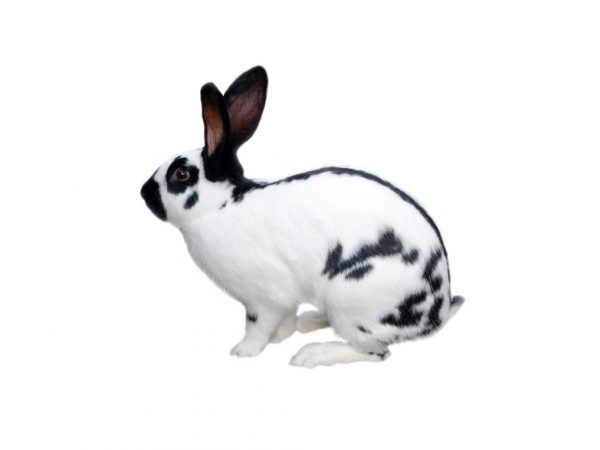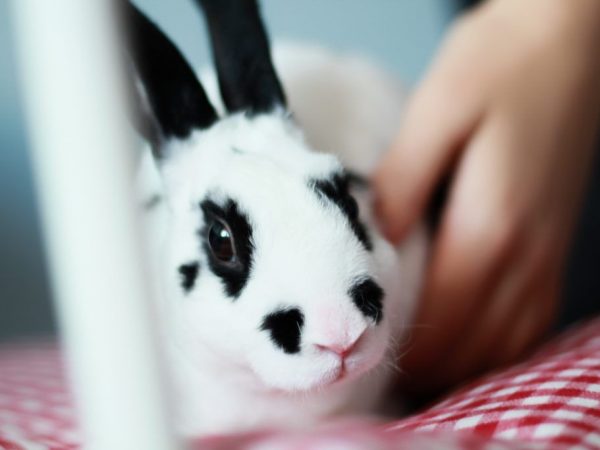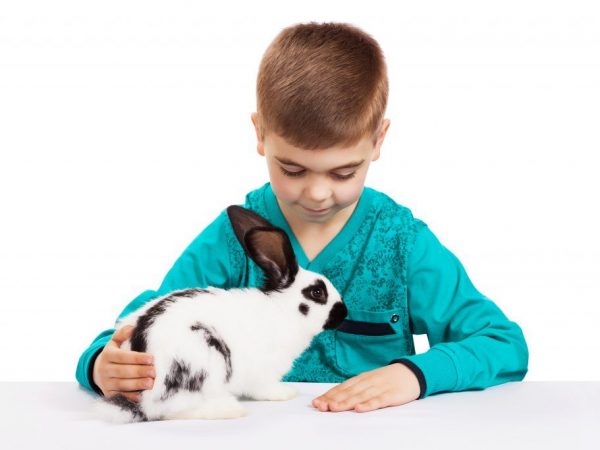Characteristics of the Rabbit Strokach
Rabbit Strokach was bred 300 years ago. When breeding, the main task was to obtain large meat rabbits. A little later, the Germans crossed Flandre with a local black and white breed and thus consolidated an extraordinary color. The main difference between the species was a black stripe running along the entire perimeter of the back.

Description of Rabbit Strokach
Exterior and general information
The Motley Stalker retained most of the parental characteristics. First of all, this is a large physique. Similarly to Flandrum, the weight of Strokachey rabbits exceeds the 10 kg mark. The breed is characterized by accelerated weight gain. With good nutrition and appropriate housing conditions, pets gain a kilogram per month.
The color of the Strokach is similar to the Butterfly breed. Dark spots resembling insect wings are clearly distinguished against a monochromatic background. Body length - up to 70 cm. Ears are long, erect. Massive paws. Compared to other breeds, the Strokach rabbit is truly a giant.
The muzzle of the rabbits is painted with a pattern that resembles the wings of a moth. Dark spots are smoothly distributed around the eye sockets, along the cheeks and nose, and partially cover the chin. The ears are also dark. A black strip stretches along the back. In addition to meat qualities, fur is highly appreciated. The pile of medium length has a neat appearance, shines in the sun. The extraordinary color makes the fur in demand in the fur industry.
Features of the
As for the early maturity of the Strokachey, rabbits of this breed reach sexual maturity in six months. During one pregnancy, the female is able to bear 10 rabbits. Rabbits do not give up babies. Rabbits are breastfed for 3 months, which strengthens the immune system.
Females and males can be very easily distinguished by their appearance. The male has a dense lean body, the head is also large, the ears are wide. Females have a neat exterior, narrow ears, and refined head lines. The most interesting thing is that the female can be easily distinguished by weight. The mass of the female exceeds the weight of the male by 10%.
How to breed
Females of the variegated Strokach breed reach sexual maturity much faster than other representatives of large-breed rabbits. The mating is carried out at 5-6 months. You can cover the female at 4.5 months, but this will have a very bad effect on the health of the future offspring and the female herself.
The survival rate of rabbits is very high. Already at 14 days, babies can leave the queen cell. In the first few days, they crawl out only at night, and then they can be in a common cage for several hours.
It is recommended to remove the rabbits from the mother at the age of 3 months. If you drop the babies half a month earlier, when the female has already stopped feeding them with milk, you can lose half of the offspring. The rabbit of the variegated Strokach breed is distinguished by a strong affection for the mother. In the case when the offspring are weaned too early from the mother, the babies lose their appetite and become lethargic.

Breeding recommendations
A characteristic feature of the breed is its uniform weight gain. Most often, 8-month-old individuals are sent for slaughter. Keeping rabbits longer is impractical because the meat quality will become worse. Among the young, there are very often individuals subject to culling. Their color is very far from the required standards. It was this nuance that hindered the registration of the breed for a very long time. Breeding involves using only the best and most productive individuals. The largest male is chosen, which has previously shown himself the best. The most prolific individual is selected from the females.
Features of the content
Representatives of the motley Strokach breed are distinguished by their large dimensions, respectively, and the dwelling for them should be spacious. You can keep rabbits in an open-air cage or in tiered cages. If it is a cage, then the flooring should be made of wooden planks. The mesh floor rubs the soles of the animals and provokes the appearance of pododermatitis.
One crawl should have an area of 1 sq. m. For females with offspring and large males, the dwelling is made even more overall: 1.6 x 1 x 55. The German rabbit has good immunity. The only thing that must be observed is the vaccination schedule and periodically prophylaxis of worms. In order to prevent coccidosis, the cells, as well as their contents, must be kept clean.
What do they eat
The variegated German rabbit has good digestion. In many European countries, where rabbit breeding is fashionable, they have long since switched to feeding with granulated feed. Such compound feed is completely balanced and besides it, animals only need water. However, in our country, such feeding is quite expensive, and rabbits have a good appetite. You can limit yourself to traditional rabbit foods:
- grain mixtures;
- mash;
- dry branches;
- green succulent grass.
Rabbits to be slaughtered must have free access to feed. To do this, it is better to design bunker feeders in cages or aviaries. Such structures are automatic and can hold an amount of feed sufficient for 3 days. The same systems should be hung in the cages of breeding rabbits. If breeding rabbits is not included in the plans, it is necessary to cut back on the rabbit's diet.
Females are fed with grass and hay in unlimited quantities, but grain and concentrated feed are given to them in portions once a day. The German rabbit is prone to obesity, which for females is threatened with infertility. If the individual is constantly used to reproduce offspring, there is no risk of obesity, because milk production burns a large number of calories. Portion feeding is also used for breeding rabbits, because obesity has a bad effect on the sexual activity of males.
Qualitative signs of purebred
If the plans include high-quality breeding with the further sale of meat and skins, then the breeder should know by what signs a purebred individual can be distinguished:
- the animal must have a bright pattern;
- dark spots are exclusively black or brown;
- weight from 5 to 10 kg;
- brown eyes;
- the pile can be variegated with a blue sheen, black, snow-white;
- the disposition is benevolent and calm;
- females never abandon their offspring.
Adult representatives are distinguished by a large physique. Rabbits can be born monochromatic, and the color begins to appear as they grow older. If an adult is aggressive, it is immediately discarded: this is not a purebred German rabbit.
Caring for felted females
After mating, when determining pregnancy, the rabbit is placed in a separate cage. Fateality can be determined by behavior: the animal becomes restless and does not react to the male during the control mating. The female carries babies for a month.During the entire gestation period, the rabbit should receive a sufficient amount of balanced food and drinking water.
Before okrol, in about a week, the rabbit begins to tear out the fur on her chest. She lays out a nest with fur for future offspring. Rabbits are born naked, so they need constant heating. If the nest is not sufficiently insulated, you should put cotton wool in it yourself. After birth, the rabbit must have enough water so that milk production begins soon.
Often in articles they write that with a lack of water, the rabbit eats the offspring. This is a misconception, because the rabbit is not a vampire. More often than not, this only happens with first-born females. Rabbits are herbivores; they cannot feed on flesh. Gnawing occurs through negligence when the female tries to transfer the babies.
Before giving birth, the rabbit should be cut off the claws so that she cannot injure the offspring. The cage should be large enough so that the female does not crush her babies. Basically, the death of offspring occurs through the fault of the owner, who could not provide the necessary care and did not take all the precautions in time.
Disease prevention
Although the German rabbit is distinguished by good immunity and perfectly adapts even to the climate of cold regions, there is a risk of getting sick if it is not kept properly. During winter, rabbits should be kept in warm indoor rabbitries. The room must be equipped with a ventilation system and protected from drafts.

Maintaining health
Rabbits can become infected with an infectious disease from carriers of the disease: sick individuals, only purchased and not quarantined, rodents and insects. As soon as the first sick individual has been found, healthy rabbits are transferred to another room and periodically checked for infection. Prevention of any disease and maintenance of immunity at a normal level are timely vaccinations.
Before being vaccinated, all animals should be treated for helminths. If there are parasites in the body, the vaccine will not work. Females are vaccinated during pregnancy only as a last resort if there is a risk of infection, so females are vaccinated before mating a couple of weeks or a month before mating.
Conclusion
As you can see in the photo, the Strokach rabbit is a giant in comparison with other breeds. The variety belongs to the meat and skin orientation. The performance profile is simply impressive. The weight of the rabbit at 4-5 months is 5 kg. The description of the characteristics of the fur and the extraordinary color make it in demand among connoisseurs of fur business. Unfortunately, breeding rabbits of this breed in our territories is not encouraged.
Strings are too expensive to maintain. However, such a fluffy giant can easily be kept in an apartment as a pet. The nature of the rabbits is calm, benevolent. Contrary to prejudice, rabbits have a highly intelligent mindset, quickly get used to the owner and are trainable. After watching the video, it is simply impossible not to fall in love with these handsome men, because the Strokach rabbit in the photo or video is especially beautiful.


